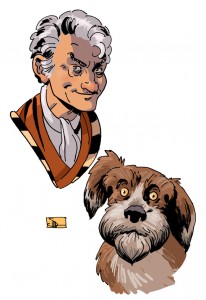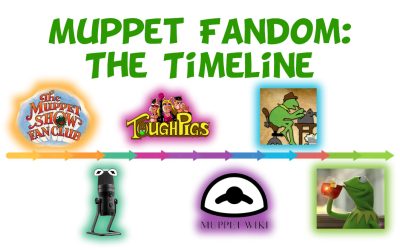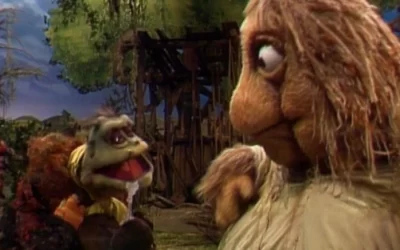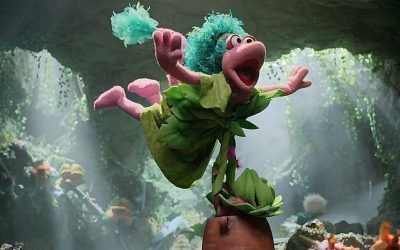Part 1 – Part 2
We here at ToughPigs have been fans of Archaia Comics for years, and ever since they merged with Boom! Comics last year, there have been a lot of really great things happening for them, and that trend has no sign whatsoever of slowing down. So when we recently had a chance to sit down with Rebecca Taylor and Cameron Chittock – the editor and assistant editor of the Henson line of comics respectively – we made sure to ask them everything we could possibly think of about every Henson comic they have in their roster. From tellers of stories to tales of sand, from Fraggles to Musical Monsters, we chatted about all our favorite funny books of the last few years, and what to expect next from the publisher. So here for your reading pleasure is an in-depth, all-inclusive interview with some of the best editors (and biggest Henson fans) in the comic book business.
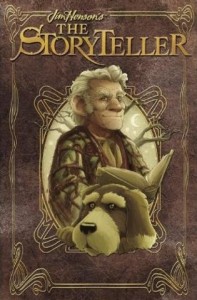 ToughPigs: Let’s Start with The Storyteller. So this is a real departure because it’s all original stories, there’s the one story that was written by Minghella.
ToughPigs: Let’s Start with The Storyteller. So this is a real departure because it’s all original stories, there’s the one story that was written by Minghella.
Rebecca Taylor: It is a departure and it isn’t from what we did before. We previously did a Storyteller anthology that came out three years ago. There were short stories in it from a bunch of different creators. One of the shorts in that was adapted from an Anthony Minghella screenplay from the show. But for this one what we wanted to do was, because it was a single issue miniseries, we wanted to have that same anthology feel of having lots of different creators bring their voices to the property, but have it be slightly longer stories so we could actually get a full fable. At Archaia we love writer-artists, people that really bring a singular vision to the story. We reached out to four creators who have very strong voices and beautiful styles, all very different from each other, and asked them, “If you could tell your Storyteller story, what would you do?” They all went out and found fairytales and fables and folklore that excited them, that got them pumped and then created either a mish-mash or a spin-off from a fairytale that we know to make their own special Storyteller fairytales. The first issue is Shane-Michael Vidaurri, who did Iron for us – which is an amazing graphic novel. He’s amazing. The second issue is Kyla Vanderklugt who has done a lot of work for us on the Spera series. The third is Matthew Dow Smith who has been prolific in comics–he does X-Files, he did Doctor Who for a while–but his creator-owned series October Girl is just dynamite. Then the last issue is Jeff Stokely, who did Six Gun Gorilla for Boom!, Reason for Dragons for Archaia, got his start on Fraggle Rock. He adapted an unproduced teleplay from the show about Baba Yaga.
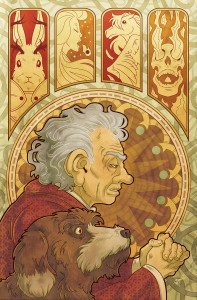 Cameron Chittock: The cool thing about having each story be an issue is that in a lot of ways it feels like an episode of the show. With that length you have the rhythm and feel of the show. When we were looking into setting up to do it, the first piece that we had was the unproduced teleplay. Since that one had Baba Yaga, who’s one of the best and most well-known pieces of witch lore, we said, “Okay, if we have one that’s already witch related, how can we do it if each story is witch-centric?” And that’s the first thing we said to the different creators. “All right, witches is the theme. Any folktale with witches.” Then it was this really fun process of digging up old fairytales and folktales. It was really cool seeing what creators were drawn to with the witch mythos. And then it was then working with Henson to see which ones were the best. We tried to make sure that different cultures of witches were portrayed as well. The second issue by Kyla is set in Japan, and the culture of Japan and the seasons play heavily into that one, which is why we did it in landscape format.
Cameron Chittock: The cool thing about having each story be an issue is that in a lot of ways it feels like an episode of the show. With that length you have the rhythm and feel of the show. When we were looking into setting up to do it, the first piece that we had was the unproduced teleplay. Since that one had Baba Yaga, who’s one of the best and most well-known pieces of witch lore, we said, “Okay, if we have one that’s already witch related, how can we do it if each story is witch-centric?” And that’s the first thing we said to the different creators. “All right, witches is the theme. Any folktale with witches.” Then it was this really fun process of digging up old fairytales and folktales. It was really cool seeing what creators were drawn to with the witch mythos. And then it was then working with Henson to see which ones were the best. We tried to make sure that different cultures of witches were portrayed as well. The second issue by Kyla is set in Japan, and the culture of Japan and the seasons play heavily into that one, which is why we did it in landscape format.
ToughPigs: That’s really cool.
Cameron: It was especially fun working with Jeff as he adapted the script, and I think his stuff in his issue is some of his best work yet. He is such a Henson guy and so influenced by the worlds Jim created.
Rebecca: His take on Baba Yaga is how Henson would’ve made a Baba Yaga puppet. It is so cool.
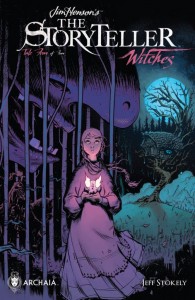 ToughPigs: It was really cool listening to him at San Diego Comic Con, you could tell how excited he was about it. So when you came up with the witches theme you sent it out to a whole bunch of creators. How many altogether?
ToughPigs: It was really cool listening to him at San Diego Comic Con, you could tell how excited he was about it. So when you came up with the witches theme you sent it out to a whole bunch of creators. How many altogether?
Rebecca: It was just those creators, they were our top choices just because we really respected their work. We wanted to get new voices in here, too. There are so many people out there who are huge names who would love to do Henson because everyone is such a huge fan of him and he’s an inspiration for so many artists that are out there, especially in comics. But this was such a cool chance for us to bring artists to single issue comics that people might not have seen before, and that’s something that the Archaia imprint really likes to do in particular. Shane and Kyla are more known for graphic novel type of work, and Matthew’s October Girl is just digital right now, so we wanted to get his full writer-artist voice into a single issue.
Cameron: And stylistically, too, that’s one of the fun things about this group is that they are so different. That’s part of what’s cool about having Shane’s issue be first is that his style, particularly how he did it in Storyteller, is just not what you see in single issue comics. I think starting the series off with that was important because it kind-of set the tone that each one was going to be very, very different and not necessarily what you expect. That’s one of the things we always talk about behind the scenes is just trying to approach things in the same spirit that Jim approached things, which was to constantly try different things, try new things, experiment, and push himself. That was one of the themes throughout his career, constantly trying things that people didn’t think he could do or that hadn’t been done before. We always try to keep that in mind when we’re doing stuff, even if it’s on a much smaller scale.
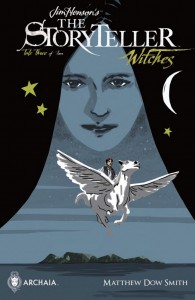 ToughPigs: So looking through the book, you can see that one character you don’t see much is the Storyteller himself.
ToughPigs: So looking through the book, you can see that one character you don’t see much is the Storyteller himself.
Rebecca: Each issue has him at the beginning and the end, or at least on one of those. He’ll be there introducing the story or ending the story in all the issues. Because you only have 22 pages in a single issue we wanted to make sure that we spent most of our real estate on the actual story itself. Everyone knows the Storyteller and the voice is in their heads. The narration, everyone knows that it’s coming from him. We wanted to get you into the story as soon as possible.
ToughPigs: Have you ever thought about doing a motion comics version and having John Hurt record them?
Rebecca: Oh man! If John Hurt wants to do something with us in any capacity, he is (leans into the mic) I want him to know that he can come to us at any point. That would be phenomenal.
Cameron: So if you have any John Hurt connections let us know.
Rebecca: Yeah, let us know!
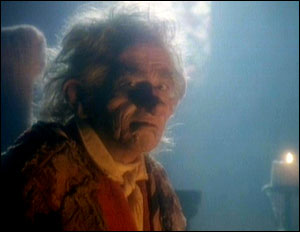 ToughPigs: I wish! I’ll see what I can do. Very cool. So going forward, do you think there would ever be another themed Storyteller like with Witches?
ToughPigs: I wish! I’ll see what I can do. Very cool. So going forward, do you think there would ever be another themed Storyteller like with Witches?
Rebecca: We would love to do that. This series is just starting out, just hit shelves today, so we’ll get a better feel for how fans are reacting to it and how it’s playing. But we love it, we hope everybody else loves it, we really believe in the stories and the creators that are in this one, and if we get a chance to do it again next year or the year after we would be stoked. I think we’d want to do a different theme. Not because we don’t like witches.
ToughPigs: And it’s cool that it’s almost like a progression because there was the original Storyteller and then the Greek Myths and it really feels like you’re extending the same brand.
Rebecca: We’re trying.
ToughPigs: So then switching over to the Storyteller novelization, is this the first time that you’ve done the novel form, prose?
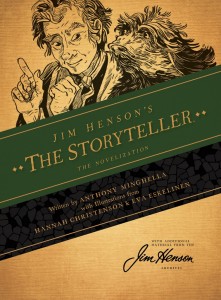 Rebecca: We’ve dabbled in prose at Archaia, but this was definitely the first reprint of an existing prose book that we’ve ever done, first novelizations, and for us as editors this was our first time really doing prose. It was really fun and it was an incredible challenge and I feel very grown-up editing a prose book, especially something as beautifully written as these. It was a great project to work on.
Rebecca: We’ve dabbled in prose at Archaia, but this was definitely the first reprint of an existing prose book that we’ve ever done, first novelizations, and for us as editors this was our first time really doing prose. It was really fun and it was an incredible challenge and I feel very grown-up editing a prose book, especially something as beautifully written as these. It was a great project to work on.
Cameron: When we approach the Fraggle Rock series or the Storyteller series, even something like Turkey Hollow, I think it’s easier for us to figure out what the direction is going to be and what we’re trying to accomplish with it. With the novelizations it definitely took a little bit of figuring out, okay, how can we make this something special, something that Henson fans are going to want on their shelves, even the ones who’ve got the original paperbacks.
Rebecca: We put pictures in it. That helped us.
Cameron: Yes! That was our first step.
Rebecca: Luckily Brian Froud helped us out with that. I think the thing that was most rewarding – and I guess not surprising since it was coming from The Jim Henson Company – but most novelizations of movies that you read are things that got cranked out to retell you exactly what you just saw in the movie. At least the ones I used to read when I was nine years old, that’s what I remember. But with these, they’re actually gorgeously written books. If you had never seen the movies, you could pick this up and just fall into it as a fantasy novel, any one of them. The Storyteller one is episodes from the show, and since every episode of the show is a fable or a fairytale, when you revert it back to prose, it just reads like a collection of amazing fairytales that feel Jim Henson-y. You wouldn’t even need to know that it was part of a TV show. And same for the Labyrinth and Dark Crystal books. A. C. H. Smith is just a phenomenal writer. Jim was heavily involved with both of the novelizations and he oversaw them and gave notes on them and really cared about people reading them as prose stories. He cared about his stories in all forms, not just on the screen, and it’s very apparent in who he picked to be the writer, how they turned out, how much he was involved, and they’re gorgeous. I have quotes from them taped on my computer.
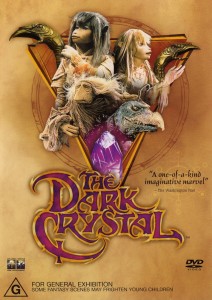 Cameron: What’s the music one?
Cameron: What’s the music one?
Rebecca: “Music is revealed, not invented.”
ToughPigs: Oh, that’s awesome.
Rebecca: Right? It’s in The Dark Crystal, it’s one of my favorite lines from that book. That was a huge part of the fun of working on them, just realizing that these were something special even just in the book world.
Cameron: I think it says so much about Jim, too, that he was the type of director who wanted to be involved and wanted to work with the novelization, wanted to show the novelization writer new drafts and what’s happening on set. You can kind-of see this played out through the Henson Company the last thirty years, but Jim had such a love for the things he was making and for the people that he was making them with, that I think that’s in each property’s DNA. I think that’s part of the reason they’re all still around and people are still passionate about them. I think that’s one of the cool things about the novelizations is that he was as invested in them as every other element of the project he was working on.
Rebecca: We get to show a lot of that in the archival material that’s in there. The Dark Crystal has a twenty page letter that he wrote to A. C. H. Smith, the writer, with all of his notes on the first draft of the book, talking about Thra and the world and how they should talk about vegetation and all this cool stuff.
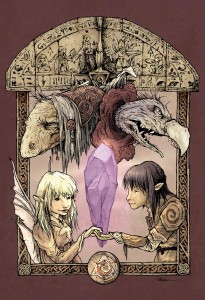 Cameron: There’s a lot of really cool world-building stuff that explains little things of how he was thinking in that early stage. It’s hearing Jim explain the world to somebody when he was still in the process of making it himself. So you can see him talking through why the Skeksis wear what they’re wearing, how they got to that point. With Labyrinth, we were able to scan Jim’s own personal journal that he used when he really fleshed out the idea for Labyrinth. It’s watching him work in real time, reading that. One of the coolest things about these books has been at conventions when we’re at the booth and people who, some of them aren’t even comics fans or didn’t even know there were Henson comics or Henson books, they just see one of our signs and they come over and are super excited about the Labyrinth book. And that moment when you show them the journal and you show them the scanned cover and you show them the scanned pages and their hands just start grabbing at it like, “I have to own this! I need to read that!” There’s still that spark about seeing Jim’s imagination at work.
Cameron: There’s a lot of really cool world-building stuff that explains little things of how he was thinking in that early stage. It’s hearing Jim explain the world to somebody when he was still in the process of making it himself. So you can see him talking through why the Skeksis wear what they’re wearing, how they got to that point. With Labyrinth, we were able to scan Jim’s own personal journal that he used when he really fleshed out the idea for Labyrinth. It’s watching him work in real time, reading that. One of the coolest things about these books has been at conventions when we’re at the booth and people who, some of them aren’t even comics fans or didn’t even know there were Henson comics or Henson books, they just see one of our signs and they come over and are super excited about the Labyrinth book. And that moment when you show them the journal and you show them the scanned cover and you show them the scanned pages and their hands just start grabbing at it like, “I have to own this! I need to read that!” There’s still that spark about seeing Jim’s imagination at work.
ToughPigs: I own three different versions of Dark Crystal on DVD because every version that came out that had something new with it. Those reprinted notebooks that they had in the one collection, that killed me when that came out. “I need this right now!” Would you maybe then recommend to people reading those notes first and then reading the books?
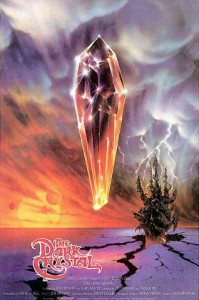 Rebecca: I think you can do it either way. It depends on how you’re approaching it. One of the fun things also about selling these at conventions is people that pick it up and mention that they’re going to read it because they loved the movies growing up and they’re going to read it to their children. If you’re approaching this book as a Henson fan and as an archival work, something for you to look at as a process, reading the notes first and then going and reading the novel would probably be the best way to do it because then you’re seeing the process in the order that it happened. But if you’re someone that is new to Henson or if you haven’t seen it in a while and you just really want a really great fantasy read, I think you should just dive into the text itself and then it’s a bonus package at the end to realize that this came from the head of a genius. Then you’re not thinking about the process, you’re just falling into the world. It was really fun also working on the packaging of these, which was a huge part of the reprinting.
Rebecca: I think you can do it either way. It depends on how you’re approaching it. One of the fun things also about selling these at conventions is people that pick it up and mention that they’re going to read it because they loved the movies growing up and they’re going to read it to their children. If you’re approaching this book as a Henson fan and as an archival work, something for you to look at as a process, reading the notes first and then going and reading the novel would probably be the best way to do it because then you’re seeing the process in the order that it happened. But if you’re someone that is new to Henson or if you haven’t seen it in a while and you just really want a really great fantasy read, I think you should just dive into the text itself and then it’s a bonus package at the end to realize that this came from the head of a genius. Then you’re not thinking about the process, you’re just falling into the world. It was really fun also working on the packaging of these, which was a huge part of the reprinting.
ToughPigs: It’s beautiful, oh my god I love that.
Rebecca: I just have to call out our designer. Scott Newman heads our design team. He did all the interior design work and type layout. They all worked tirelessly on that. Having to ask a bunch of comic book designers to switch to prose is (laughs) never something you want to do. But they were champions. And then we worked with a studio called Faceout Studios, in particular a designer named Charles Brock who was amazing to work with. He’s one of these guys who loves Henson, loves books. He rewatched all the movies and came back to us with all this imagery and all these different options for how we could approach the design and this is the way we ended up going. He really got what we were doing with it being a celebration of Jim, it being a fantasy collection, a process work and archival project. He just nailed it. I just love his designs.
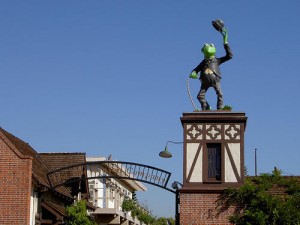 ToughPigs: So going back to talking about the archives, is that something that you guys are allowed access to? Do you go to Henson and they’re just like, “You can look through and pick out whatever you want”? Or do they come to you with specific things in mind?
ToughPigs: So going back to talking about the archives, is that something that you guys are allowed access to? Do you go to Henson and they’re just like, “You can look through and pick out whatever you want”? Or do they come to you with specific things in mind?
Rebecca: It’s like one of those things where you win a prize and you can go to the shopping mall and you can just dump stuff into your cart in half an hour.
ToughPigs: The Toys-R-Us Shopping Spree, yeah!
Cameron: Sure! The first Kermit’s at my desk right now, hanging out.
Rebecca: I’ve actually never had the privilege of going into the archives. They’re in New York, on Long Island. They have an incredible woman named Karen Falk who is the archivist –
ToughPigs: Oh, she’s fantastic.
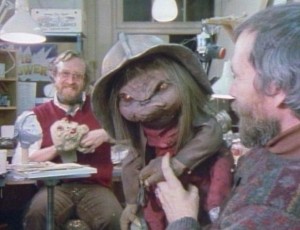 Rebecca: She is just amazing. We love her. And she knows everything that there is in that. I imagine it being this beautiful vault, this magic vault and that you can walk into. That’s probably not how it is. But she knows everything. It’s kind-of a back and forth of us saying, “Okay, what else do you have that is exciting” and her going in and being like, “Oh, well these are the things that we could work on,” and us doing a back and forth about what she’s got that she’s passionate about, that the company is passionate about telling, and then us saying what we think could work as a comic and what we’re excited about translating. Stephen Christy [President of Development] has been to the archives before.
Rebecca: She is just amazing. We love her. And she knows everything that there is in that. I imagine it being this beautiful vault, this magic vault and that you can walk into. That’s probably not how it is. But she knows everything. It’s kind-of a back and forth of us saying, “Okay, what else do you have that is exciting” and her going in and being like, “Oh, well these are the things that we could work on,” and us doing a back and forth about what she’s got that she’s passionate about, that the company is passionate about telling, and then us saying what we think could work as a comic and what we’re excited about translating. Stephen Christy [President of Development] has been to the archives before.
Cameron: Yeah.
Rebecca: And he said it was a magical moment. I imagine it being like that.
ToughPigs: You enter through a hollowed-out tree and –
Rebecca: I know! I almost don’t want to go, it’ll break the illusion of what it would look like.
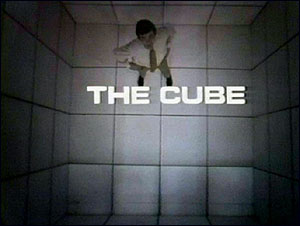 ToughPigs: It’s just a big gray room with one filing cabinet at the end.
ToughPigs: It’s just a big gray room with one filing cabinet at the end.
Cameron: I still remember the call where Karen and we were talking, figuring out what we were going to put in the novelizations and she just comes back with Brian Froud art that’s never been seen before and Jim’s journal and we’re like, “Oh my god, this is the coolest thing ever!” The relationship with them is just great.
Rebecca: Ultimately, it all comes from them, what they’re excited about doing, and luckily they trust us a great deal, which is wonderful and an honor that they trust us to work with anything at all from his archives, let alone stuff as great as the novelizations or Turkey Hollow or Tale of Sand. The chances to do those are just huge so we thank them.
ToughPigs: So Tale of Sand, let’s go back to that one. Was that something that they came to you with?
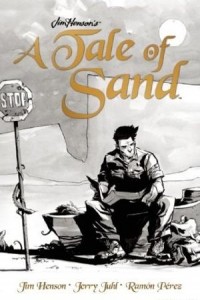 Rebecca: I don’t know who chicken-and-the-egged that one. Stephen Christy was the one who spearheaded Tale of Sand, he was the editor on that, he was in charge of the whole Henson line at that time. I don’t know whether he found the screenplay in the archives or if Karen brought it to him, or who found it first. But he definitely latched onto it as this awesome, amazing potential project. They worked together to make it a reality. And when they found Ramon Perez, that was when it all clicked, this incredible artist who just got it and could translate Jim’s vision into something that you can actually see. With the illustrated screenplay that’s part of the boxset, we wanted there to be a companion piece to the graphic novel, where you actually just get to see Jim’s screenplay.
Rebecca: I don’t know who chicken-and-the-egged that one. Stephen Christy was the one who spearheaded Tale of Sand, he was the editor on that, he was in charge of the whole Henson line at that time. I don’t know whether he found the screenplay in the archives or if Karen brought it to him, or who found it first. But he definitely latched onto it as this awesome, amazing potential project. They worked together to make it a reality. And when they found Ramon Perez, that was when it all clicked, this incredible artist who just got it and could translate Jim’s vision into something that you can actually see. With the illustrated screenplay that’s part of the boxset, we wanted there to be a companion piece to the graphic novel, where you actually just get to see Jim’s screenplay.
Cameron: What’s cool is with the screenplay is I think you actually get more appreciation for both Jim and Jerry Juhl’s vision for the film, but also Ramon’s ability to adapt it and the way he approached the adaptation. From panel layouts to character designs to the aesthetic of the world. It is so cool to see the document he was given and how he then turned that into Tale of Sand. There were some scenes from the script that Ramon had done layouts for but that didn’t end up making it into the graphic novel. Ramon illustrated two of those scenes for the first time for the screenplay book and they came out amazing. Any time you can see new Ramon Perez work in its black and white inks is something to be thankful for.
ToughPigs: Yeah, he’s fantastic.
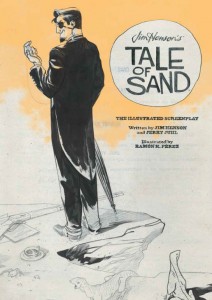 Rebecca: And there are tests from other incredible artists that tested on the book that didn’t end up being the artists that we went with, but their tests are all incredible and it’s so cool to see their interpretations of Jim’s Tale of Sand. It’s fascinating to see how completely differently you can interpret it.
Rebecca: And there are tests from other incredible artists that tested on the book that didn’t end up being the artists that we went with, but their tests are all incredible and it’s so cool to see their interpretations of Jim’s Tale of Sand. It’s fascinating to see how completely differently you can interpret it.
Cameron: That’s the cool thing about the script, too–it’s really unique in that it has a very clear through-line, it clearly has something to say and it’s so purposeful in its imagery and its storytelling. But at the same time, it’s so surreal, which is something that Jim and Jerry were both very interested in as storytellers at that point. But it’s so surreal that you can give different artists the script and it would be a totally different book but still very much Tale of Sand. I think Ramon makes a joke that there’s alternate realities where there’s all sorts of different Tale of Sands just by different artists. I was really glad we were able to put those test pieces in the back. One, because they’re amazing artists and their takes on Tale of Sand are beautiful. But also just for fans to see how the work can be interpreted. There was a point early on where Jim was going to play Mac himself, so one of the tests is actually a scene but where Jim is the main character, which is obviously not what they ended up going with but really cool to see, to see Jim in these scenes that you’ve read from the graphic novel with a different artist interpreting it.
ToughPigs: That’s really cool. So it was pretty immediate when they saw Ramon? It was like, “This is the guy!”
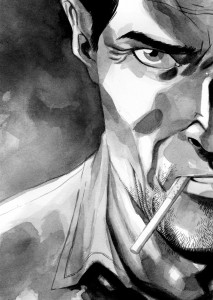 Rebecca: I remember when his first tests came in and they were sort-of like illustrations, they weren’t even pages, they were just pieces about it. One of them, I think we still have on a poster somewhere, it’s just Mac, it’s just a greyscale of him looking out at this vista, and another one of him sitting on a log. The mood of it – he just got it. It was like tingles when they came in. You could feel this desert and this windswept, empty, vast landscape. I wasn’t involved in the project at that point so I just saw them come in and I was like, “Oooh pretty, grabby hands.” But yeah, he just nailed it. He was the guy.
Rebecca: I remember when his first tests came in and they were sort-of like illustrations, they weren’t even pages, they were just pieces about it. One of them, I think we still have on a poster somewhere, it’s just Mac, it’s just a greyscale of him looking out at this vista, and another one of him sitting on a log. The mood of it – he just got it. It was like tingles when they came in. You could feel this desert and this windswept, empty, vast landscape. I wasn’t involved in the project at that point so I just saw them come in and I was like, “Oooh pretty, grabby hands.” But yeah, he just nailed it. He was the guy.
Cameron: One of the fun things of doing the screenplay is that you have perspective now on the brilliance of Ramon. Not just in Tale of Sand but in terms of the comics landscape. He’s one of the best artists working. And I think Tale of Sand plays to all of his strengths. One of the things I always think about when I think of Mac is just the detail on the type of shirt he’s wearing and the type of boots he’s wearing. There’s just the little things in how Ramon does clothes that always sticks out. Little things like that. Then of course the double page spreads where he’s got all this surrealist imagery and yet it makes total sense. That guy’s the best.
ToughPigs: Yeah, he’s one of my favorite Instagrams to follow. All of his in-progress stuff, man it’s fantastic.
Rebecca: And then he shows a picture of his beard.
ToughPigs: Yeah, and what he’s drinking.
Rebecca: That’s why you stick around, for the beard.
Cameron: It’s either the glorious food that he’s eating, the glorious art he’s drawing, or his glorious beard. One of the three.
Stay tuned for part two of our interview with the editors of Archaia’s Henson books, coming later this week!
Click here to save a place by the fire for the ToughPigs forum!
by Matt Wilkie

